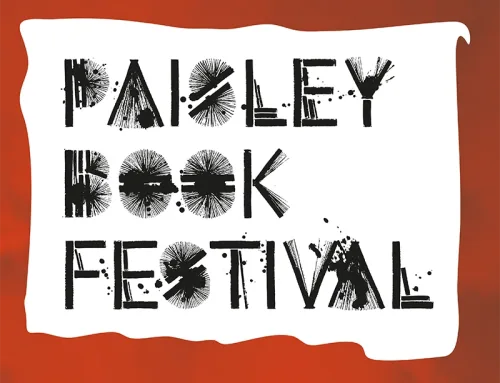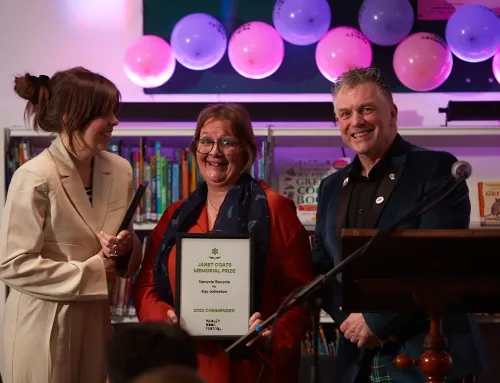Maggie Ritchie, journalist and author saves the day, stepping in for Sally Magnusson at the eleventh hour at an event chaired by Paisley Book Festival’s Associate Programmer Jess Orr.
If we are to weave the festival thread through the flow of events, then Maggie Ritchie’s latest novel Daisy Chain can clearly be seen to continue the themes of the session which preceded it. In the earlier talk, women’s footballing legend, Rose Reilly exposed the extent to which women were denied the right to participate in activities that took place in spaces reserved for men. Daisy Chain is a book about female artists trying to make art in a world in which women are largely excluded, undervalued and all too often, overlooked. The two main protagonists, both painters from the artist-town of Kirkcudbright, move to Glasgow to attend the newly built Charles Rennie Mackintosh School of Art.
What is striking about the art world at the 20th century’s dawn, is that women were much more readily accepted into formalised academic structures than in other more ‘masculinised’ disciplines such as engineering, the ‘natural’ sciences, and even the humanities - including history and philosophy. Maggie exploits this anomaly, to expose the extent to which the art world in Glasgow (and wider Europe) in the early 1900s, was, despite its apparent openness, a world in which bourgeoise white men still decided what kind of art people wanted to buy, and by association, what kind of art ‘deserved’ to get made.
Maggie’s first reading from the book was a rare treat that readers of any author’s work rarely get to enjoy. The setting is a symbolic exchange between the painter whose art depicts something of a ‘realist subject matter’ and the art dealer, a businessman, whose priorities ultimately lie in the profit motive. Although the art dealer acknowledges the fact that the artist’s work is indeed of the very highest standard, he takes issue with the subject matter. He informs his hopeful client that this time he will neither be purchasing her paintings nor showing them in his gallery because ‘no one wants to see the grim reality of poverty and destitution on their own doorstep’.
The tale entwines the struggle of women in the early 20th century art world with the resilience developed through female friendships as they forge their artistic identities in a hostile environment dominated by men. The story unfolds through this friction between the freedom required to break new artistic ground, and the stuffy and stifling reality of art markets in which men have a monopoly over the legitimate right to decide what art is, what is relevant and what is ‘good’.
Much of the discussion at the event focused on the research for this novel, an endeavour that not only took Maggie across Scotland but also to Shanghai where a segment of the novel is set. In researching the book, Maggie was inspired by the McDonald Sisters, one of whom was married to Charles Rennie MacIntosh. Both sisters were magnificent artists in their own right, but sharing a similar fate to that of her protagonists, they struggled to find the success they deserved. Maggie is not only interested in the hidden histories of women, an act of resistance in itself, she brings these common-place realities to life in her books. At the beginning of the novel the two girls are lying in the grass making a daisy chain, an activity that symbolises a bond, this time one that will not only endure but that will provide the foundations of a resilience required to succeed in the face of masculine domination.
Maggie’s accounts of her research trip to Shanghai are both encapsulating and informative. She was surprised to discover just how European certain parts of the city still were. It was, she said, like stepping back in time, and the beautifully old-fashioned architecture could easily give the impression of being in any European city in the 1920’s. What added to the charm of the place was the flowering of the Osmanthus flower, which blooms in October, giving the entire city a wonderful aroma. As Maggie pointed out, this sweet smell is juxtaposed by the fact that the city would have provided great wealth to many Glasgow merchants at the end of the 19th Century, riches that came from the misery induced by the booming opium trade which the British Empire was all too willing to exploit.
This was a fascinating event which explored the themes of female friendship, gender dynamics and the oppressive realities of the patriarchy, even for women who occupied more favourable positions in social space. The book also explores what it is to be an artist and the importance of artistic freedom.
Fans of Maggie’s books will be pleased to hear that she is currently working on her fourth novel which is due for submission at the end of this year, beginning of next. By the sounds of things, those interested in her recurring themes of female friendship, resilience and the hidden histories that inform her stories will not be disappointed.









